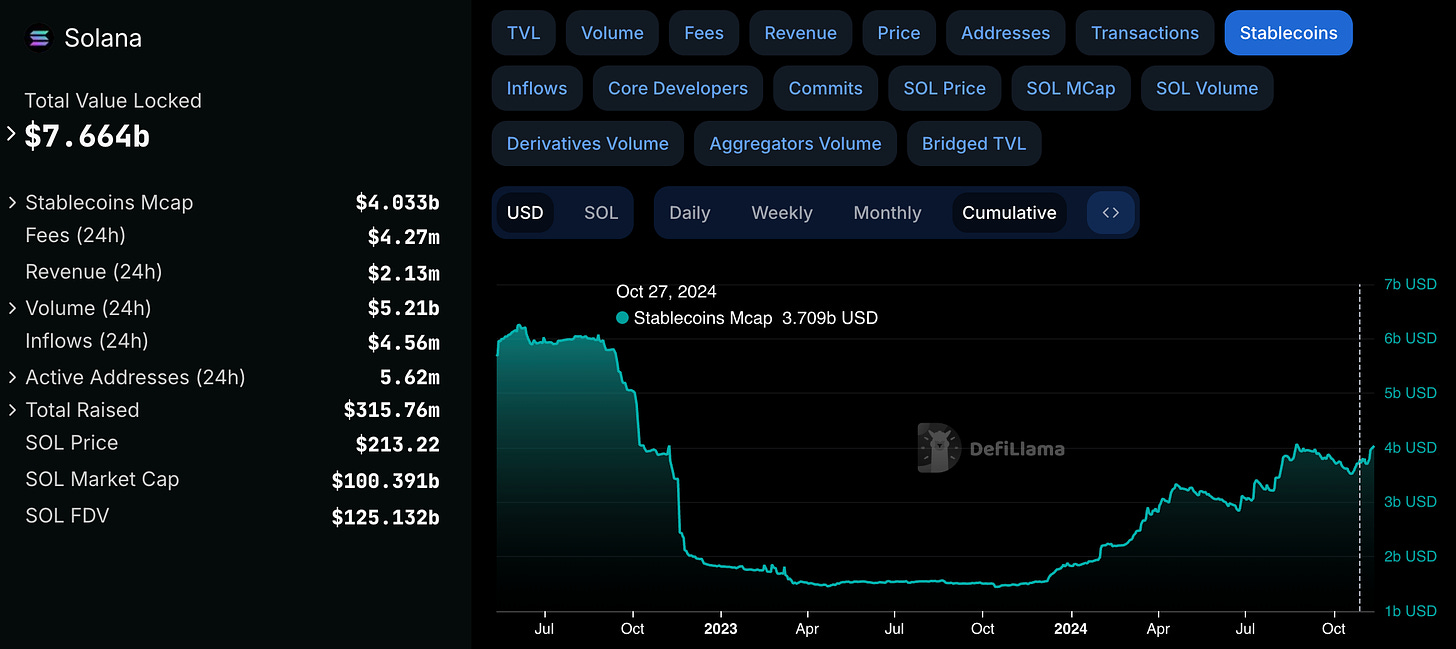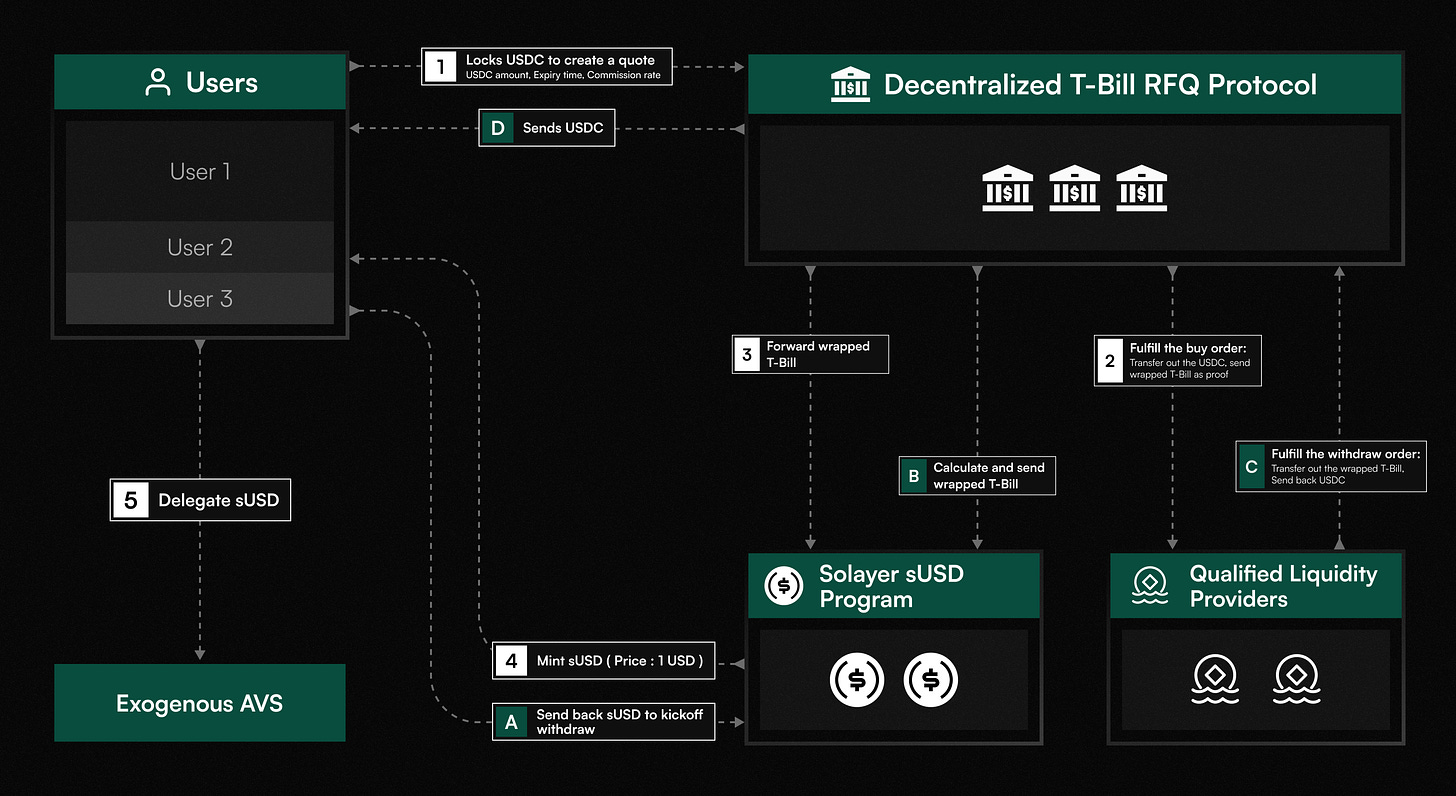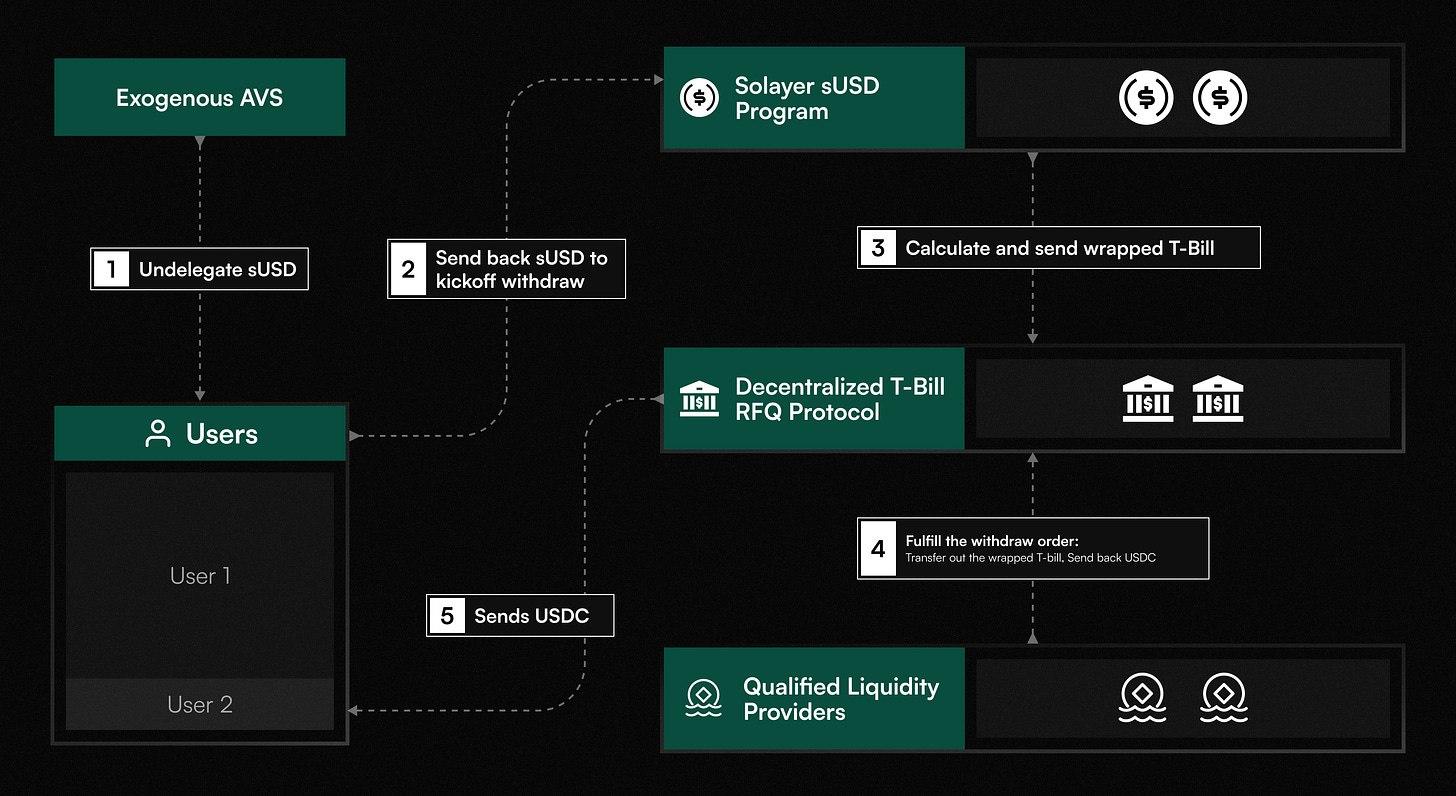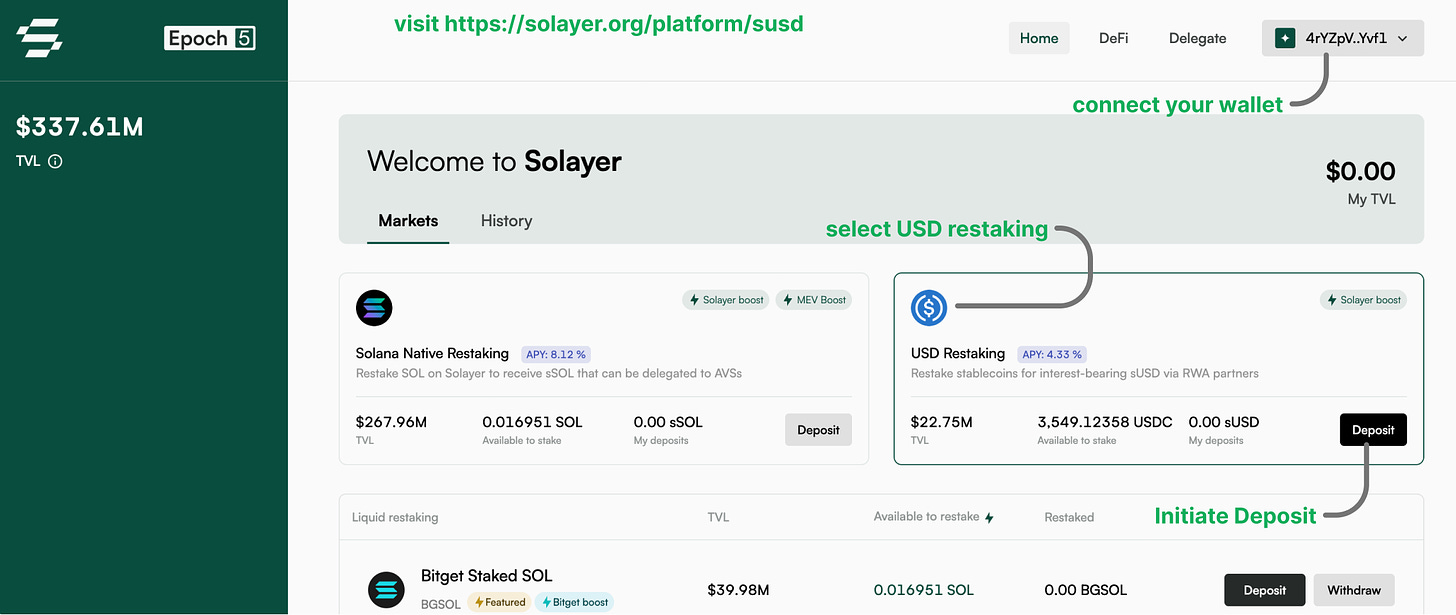Solayer sUSD: Transforming Stablecoin Utility on the Solana Blockchain
Understanding the Restaking Model and Benefits of Solayer’s Yield-Bearing Stablecoin.
Imagine setting aside some savings, feeling secure that you've taken a step toward a stable future. But as time goes on, that sense of security begins to fade. Prices gradually rise — groceries, gas, and everyday essentials become more expensive. This is inflation, slowly eroding what your savings can buy. What once felt like a reliable safety net starts to lose its strength, making it harder to plan for the future.
Storing savings in a bank account might feel safe, but without growth, those savings are steadily losing value. Traditional stablecoins, pegged 1:1 to the dollar, offer a digital alternative, holding a steady value that mirrors the dollar. However, they don’t earn interest or grow, providing no real defense against inflation’s constant creep.

This growing need calls for a new type of stablecoin—one that not only holds its value but also grows by generating yield. Such a stablecoin would let people keep their savings in a dollar-pegged asset that earns interest, helping to fight inflation’s impact. If this stablecoin is decentralized, it also eliminates dependency on traditional banks, allowing people a safe, independent way to build and grow their wealth.
Recent events underscore the risks of relying on centralized banks. For instance, when Silicon Valley Bank collapsed, $3.3 billion of Circle’s USDC reserves were locked up, causing USDC to temporarily lose its 1:1 peg to the dollar, as highlighted by the Wall Street Journal. This situation illustrated how centralized bank dependencies can destabilize assets pegged to the dollar. A decentralized, yield-generating stablecoin like sUSD could offer a more resilient solution, enabling people to protect their savings without being vulnerable to traditional banking crises.

Introducing sUSD: A Yield-Bearing Stablecoin for Modern Financial Needs
sUSD was created specifically to address the growing need for a stablecoin that offers both security and growth. As a yield-bearing asset on the Solana blockchain, sUSD combines the stability of a dollar peg with the advantage of earning passive income through USD restaking. Users can restake stablecoins for sUSD, Solana’s first yield-bearing stablecoin backed by U.S. Treasury Bills, making it an ideal choice for those seeking both stability and returns.
Unlike traditional stablecoins, sUSD generates a consistent yield of 4-5% annually, supported by a diverse mix of low-risk real-world assets such as U.S. Treasury Bills, gold, and other investment-grade assets (RWAs). This approach positions sUSD as a stable store of value and a safeguard against inflation, establishing it as a powerful tool in decentralized finance and a smarter alternative to traditional savings.
More than just another stablecoin, sUSD is designed to support a bank-free financial system. By offering both stability and growth, it provides users with a simple way to grow their savings independently of traditional banks, making it a valuable addition to Solana’s expanding financial ecosystem.
As of today, stablecoins have a Total Value Locked (TVL) of $107.13 billion across all chains and $4.03 billion on Solana, making them essential to blockchain and DeFi. They provide stability and liquidity, allowing for smooth transactions, lending, and trading in a volatile market.

Core Technical Elements of sUSD
sUSD stands out with features that make it a powerful stablecoin, offering stability, yield generation, and decentralized accessibility. Let’s explore the key elements and the processes that make sUSD unique.
1. Yield Generation
sUSD is designed to offer a consistent annual yield of 4-5%, backed by secure real-world assets like U.S. Treasury Bills, gold, and other high-quality investments. Users automatically earn this yield as long as they hold sUSD, thanks to Solana’s Token2022 technology. This system gradually increases users' balances over time without requiring complicated staking or extra steps, making yield earning simple and accessible.
2. Request-for-Quote (RFQ) System
The RFQ system is a decentralized, non-custodial protocol that streamlines yield distribution and liquidity management:
Simplified Access: Users can engage with multiple real-world asset providers through a single interface, eliminating the need to manage multiple platforms.
Risk Distribution: By involving different liquidity providers, the system spreads risk and maximizes yield opportunities.
Future Expansion: As new real-world asset partners join, the RFQ system becomes even more efficient and robust.

3. Processes Involved in sUSD Operations
sUSD operates through two main processes: Subscription (minting sUSD) and Redemption (withdrawing USDC).
Subscription Process (Minting sUSD)
The steps to mint sUSD are as follows:
Locking USDC: Users lock USDC in the sUSD protocol to start the minting process. The system generates a quote, including the amount of USDC, expiry time, and commission rate.
Order Fulfillment by Liquidity Providers: Qualified Liquidity Providers (QLPs) compete to fulfill the order. They deposit USDC into the T-Bill vault and receive tokenized T-Bills. These wrapped T-Bills are forwarded to the sUSD minting program.
Minting sUSD: The sUSD protocol locks the wrapped T-Bills and mints sUSD, maintaining a 1:1 peg with USDC. The minted sUSD is then transferred to the user's wallet.
Optional Delegation: Users can optionally delegate their sUSD to secure Exogenous Actively Validated Services (exoAVSs) for additional rewards, enhancing the security of decentralized systems.
Redemption Process (Withdrawing USDC)
The steps to redeem sUSD and get USDC back are:
Undelegating sUSD: If users have delegated sUSD to exoAVSs, they must first undelegate it before proceeding.
Returning sUSD: Users initiate the withdrawal by sending sUSD back to the protocol.
Calculating Wrapped T-Bills: The protocol calculates the equivalent amount of wrapped T-Bills needed for the withdrawal.
Order Fulfillment by Liquidity Providers: QLPs redeem the wrapped T-Bills and exchange them for USDC from the T-Bill vault. They then transfer the USDC back to the protocol.
USDC Returned to the User: The protocol completes the process by transferring USDC to the user, finalizing the redemption.
4. Key Players in the RFQ System
Users (Stablecoin Restakers): Users participate by locking USDC to mint sUSD, earn yield, and can delegate sUSD to secure decentralized systems. They also set commission rates to incentivize liquidity providers.
Qualified Liquidity Providers (QLPs): QLPs ensure smooth transactions and sufficient liquidity. They manage assets, deposit USDC to receive tokenized T-Bills, and process user withdrawals, holding TBILL tokens securely in their vaults.
5. Management and Oversight
Token Issuer (Hill Lights International Limited): Oversees the creation of TBILL tokens and adheres to strict regulations to ensure security and compliance.
Investment Manager (Adam Eve Capital): Manages investments in secure assets like U.S. Treasury Bills, focusing on stability and returns.
Fintech Service Provider (OpenEden Labs Pte Ltd): Manages the technology and infrastructure, ensuring efficient and secure operations without being a regulated financial entity.
This is how the technical framework of sUSD brings together security, yield, and decentralized accessibility. Backed by real-world assets, sUSD offers a stable 4-5% yield, while its permissionless, decentralized RFQ system enables seamless liquidity and transactions without requiring centralized intermediaries. The efficient minting and redemption processes, optional delegation for additional rewards, and open-access design make sUSD a reliable, income-generating alternative to traditional stablecoins, supporting both individual wealth growth and the decentralized finance ecosystem.
Security & Decentralization: How sUSD Secures External Systems (exoAVS)
sUSD is designed to protect both its users and external systems (exoAVS) that rely on it, by combining transparency, secure asset management, fair pricing, and thorough security checks.
Transparent Transactions on Solana
sUSD runs on the Solana blockchain, where every transaction and T-Bill holding is recorded for anyone to see. This creates a public, unchangeable record that lets users and external systems verify where assets are at any time, building trust and confidence in the system.
Safe Asset Storage with PDAs
Each market maker uses a secure account, called a Program Derived Account (PDA), to hold their assets. This setup keeps assets safe and separate, reducing the chance of unauthorized access or mismanagement. This extra layer of protection helps ensure that external systems relying on sUSD are secure.
Fair Pricing Through Decentralized RFQ Protocol
sUSD’s decentralized RFQ (Request-for-Quote) protocol allows market makers to compete for transactions, without needing any central authority. This keeps pricing fair, prevents manipulation, and ensures that everyone operates in a trustless, transparent environment, which strengthens the financial security of external systems connected to sUSD.
Regular Audits and Security Checks
sUSD’s security measures include regular audits and thorough checks on liquidity providers to make sure assets are managed responsibly. These ongoing security practices make sUSD reliable and stable, which is crucial for both users and external systems that depend on it.

By combining transparent transactions, secure storage, fair pricing, and strong security checks, sUSD provides a safe and dependable foundation for external systems, helping build a more decentralized, open financial ecosystem.
While sUSD is designed to provide steady yields through backing by assets like T-Bills, users should keep in mind that no investment is completely risk-free. Economic shifts and market fluctuations may influence the value or returns of the underlying assets. It’s important for users to consider these factors when deciding to hold sUSD as part of their financial plans.
Key Use Cases of sUSD
Savings Solution
sUSD provides a stable, yield-bearing alternative to traditional savings on Solana, with a consistent 4-5% yield backed by U.S. Treasury Bills, making it ideal for growing wealth passively.Collateral for Lending and Borrowing
sUSD can be used as collateral in lending protocols like Kamino, Drift Trade, Save Finance, and Lulo. By supporting sUSD, these platforms allow users to borrow and lend with reduced risk and favorable terms, enhancing capital efficiency in DeFi. Lulo, in particular, optimizes yield by automatically tracking interest rates across Solana DeFi, moving deposits to the highest-yielding opportunities. This automated process ensures users earn maximum returns without the need for constant manual adjustments.Perpetual and P2P Trading
If pool-to-peer trading platforms like Parcl Protocol and Flash Trade adopt sUSD over traditional stablecoins, liquidity providers could benefit from additional APY, boosting their returns and making sUSD an attractive choice for those supplying liquidity.Liquidity Pool Pairing
sUSD can be adopted as a token pair on AMM protocols, allowing liquidity providers to earn both trading fees and yield, thereby strengthening Solana’s liquidity ecosystem.Raydium and Orca now support sUSD as a token pair in their liquidity pools. Raydium has launched an incentivized sUSD-USDC pool, and Orca offers an sUSD-SOL pool, expanding sUSD’s role in Solana’s DeFi ecosystem and providing users with new yield opportunities.
Securing Decentralized Systems
sUSD can be staked to secure exogenous systems (exoAVSs) like oracles and bridges, rewarding users for supporting Solana’s decentralized infrastructure.Global Payments
sUSD can be used for international payments, supported by platforms like Cypher Wallet and Kast Card, allowing users to send sUSD globally. This use case provides a stable, yield-bearing digital currency option for efficient cross-border transactions.
Onboarding to the Solayer Dapp for sUSD Restaking
sUSD restaking is built to be straightforward and accessible, allowing users to quickly begin earning yield with just a few steps through the Solayer dashboard.
Access the Dapp
Go to the Solayer Dapp. Once there, you will see a dashboard displaying the Total Value Locked (TVL), available markets, and other options.Connect Your Wallet
Ensure your Solana-compatible wallet is connected to interact with the Dapp.Select USD Restaking
In the "Markets" section, choose "USD Restaking." Here, you can view details such as the APY (4.33%), total TVL, and available amount for staking in USDC.Initiate Deposit
Click the Deposit button under the USD Restaking option. Enter the amount of USDC you wish to deposit, which will be converted to sUSD for yield generation.Confirm Deposit Details
After entering the deposit amount, confirm the transaction details. You’ll see a prompt indicating the expected APY and your deposit amount.Processing Transactions
Once you confirm, the transaction will begin processing. In the "Processing Transactions" section, you will see each deposit in a "Settling" status, indicating that your deposit is being converted into sUSD.Wait for Settlement
The conversion process may take up to two days (T+1) to complete. During this time, the system processes your deposit with Solayer's partners.Monitor Your Balance
Once the transaction is complete, your wallet will display the sUSD balance. You can track interest accrual over time directly on the Dapp.
Alternatively, you can directly swap USDC or other stablecoins to sUSD via Jupiter DEX for faster access to sUSD.

Solayer's Community-Driven Governance
Solayer has introduced a points system aimed at rewarding early contributors and active community members, which may eventually lead to the release of their own token. This token will have several uses, especially in governance. In my opinion, token holders could stake their Solayer tokens to gain voting power, allowing them to participate in key decisions. For instance, they could vote on proposals regarding asset allocation across various categories such as Treasury Bills, gold, bonds, and other real-world assets (RWAs). This governance model would enable the community to influence the platform’s financial strategy and asset distribution, fostering a genuinely community-driven project.
Competitive Landscape for sUSD
In the world of yield-bearing stablecoins, several competitors are taking different approaches:
Rebase Tokens: These tokens, like USDY (Ondo), BUIDL (BlackRock), and USDM (Mountain Protocol), adjust user balances automatically by distributing rewards as additional tokens, all while maintaining a stable 1:1 peg to the dollar. For example, USDY by Ondo Finance is a yield-bearing token backed by U.S. Treasuries that accrues interest daily, simply by holding it.
Non-Rebase Tokens: These tokens don’t adjust user balances but generate yield through other methods:
Staking/Derivatives: Tokens like USDe (Ethena) generate yield by staking collateral, where users earn rewards through the increased value of their staked token (sUSDe).
DeFi Lending: Yield here is generated by collateral and lending interest. Examples include DAI (Maker), GHO (Aave), and crvUSD (Curve).
Carrot on Solana: Carrot is a Solana-based app that automatically optimizes stablecoin yield by monitoring platforms like Kamino and MarginFi, using a single yield-bearing token to simplify investments.
Another great mention is ISC (International Stable Currency), a unique flatcoin designed to preserve purchasing power by resisting inflation. ISC is backed by a basket of real-world assets (RWAs), allowing it to avoid the usual issues of currency devaluation due to money printing.
Despite competition, sUSD stands out with its unique advantages, including auto-rebase interest that distributes yield automatically. Backed by real-world assets like U.S. Treasury Bills, sUSD provides a stable, inflation-resistant way to grow savings. Its seamless integration into DeFi makes it ideal for use as collateral and liquidity within Solana’s ecosystem, supporting stable growth and driving innovation.
Conclusion
sUSD is establishing itself as a powerful stablecoin on Solana, blending stability, earning potential, and versatile uses. Offering a secure option for savings, lending, borrowing, and global payments, sUSD enables users to grow their wealth independently, without the need for traditional banks. With cross-chain expansion plans via Wormhole, sUSD is set to boost liquidity and unlock new value across DeFi ecosystems on multiple blockchains.
Stay updated by following Solayer on Twitter and joining their community on Discord.
Don’t let inflation eat away at your purchasing power—put your savings to work with Solayer’s sUSD restaking and enjoy a steady 4-5% yield.
References
- Solayer sUSD Docs: https://docs.solayer.org/susd/what-is-susd
- sUSD Litepaper: https://github.com/solayerdev/solayer_docs/edit/main/susd/decentralized-rfq/overview.mdx
- Solayer YouTube Channel: https://www.youtube.com/@solayer_labs
- Solayer Blog: https://solayer.org/resources/blogs
- DeFiLlama Dashboard: https://defillama.com/protocol/solayer?usdInflows=true&tvl=true
- Solayer Website: https://solayer.org/platform/susd


















